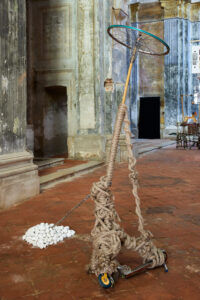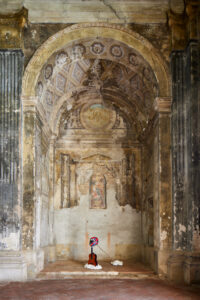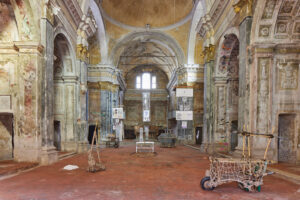Twenty years after receiving the Rome Prize, Jamaican artist Arthur Simms (Saint Andrews, Jamaica, 1961) returns to Italy with a solo exhibition in the deconsecrated church of San Carlo, in the heart of Cremona. Converted into an artistic space in 2021, after a significant restoration work following a long period of neglect and abandonment, San Carlo offers an exhibition programme aimed at building a dynamic dialogue between contemporary art and the historical memory of the city. So far, the curatorial project has hosted a cycle of leading international artists such as Mark Handforth, Dara Friedman and Robert Janitz, chosen by Servane Mary, with whom San Carlo inaugurated the seventeenth-century space and established a collaboration that continues to this day.

Arthur Simms, I Am The Bush Doctor, One Halo, 2023, installation view at San Carlo Cremona. Courtesy the artist, Martos Gallery and Apalazzogallery. Photo credit: Form Group
Simms’ exhibition, entitled I Am the Bush Doctor. One Halo, consists of a large corpus of works inspired by the church, embracing a multitude of materials and languages such as drawing, sculpture and photography. As a whole, the exhibition offers a comprehensive overview of the poetics and research of the artist, whose practice can be defined as a skilful exercise of assemblage and collage. Simms began to engage in this practice as a child in Kingston, Jamaica, observing local craftsmen who, unable to afford new carts for the market, were forced to create rough imitations using old wheels and used boxes. Similarly, Simms started inventing all sorts of toys by combining together everyday objects such as wood, plastic, pieces of rope, corks, feathers and gum. Over the years he has collected the most disparate objects, developing an intuitive assemblage process, influenced by Duchamp’s lessons of the ready-made and Surrealism. Since the 1990s, the artist has introduced iron wire and hemp fibre, which he wraps around his installations, inspired by Jackie Winsor’s work Bound Square (1972). For Simms, it is about “giving the sculpture a see-through skin.” By weaving what appears to be an ever-expanding tangled web, the artist crosses-imposed gender boundaries using a technique similar to embroidery and sewing usually attributed to the female domestic sphere.

Arthur Simms, Il Santo Del Mare, 2023, wire, bamboo, wheel, metal, stones, 205 x 191 x 92 cm. Courtesy the artist, Martos Gallery and Apalazzogallery. Photo credit: Form Group
The playful character of the installations is counterbalanced by a cultural-historical component. Through this combination, Simms explores through a humorous filter the interconnections that produce multicultural identities triggered by the phenomenon of globalisation and the African diaspora. The objects of the assemblages are rich in symbolic and iconographic references belonging to both American and Jamaican popular culture, as well as European and Aboriginal music and art history. Mixed in with these are autobiographical quotations from life first in Jamaica and then in New York, USA. Simms’ assemblage work can be placed alongside that of other Afro-descendant colleagues such as the multidisciplinary artist Lonnie Holley, who uses abandoned objects to narrate personal and collective events.

Arthur Simms, La Luce, 2023, wood, rope, wire, glue, aluminum foil, screws, wheels, 508 x 208 x 105 cm. Courtesy the artist, Martos Gallery and Apalazzogallery. Photo credit: Form Group
The cultural contamination is clearly visible in the works on display at San Carlo. For example, the term Bush Doctor, in the title of the exhibition borrowed from the drawing hanging above the altar, refers to Jamaican singer Peter Tosh’s 1978 song dedicated to doctors in Jamaica who treat physical ailments by resorting to home-made concoctions. It is a practice also carried out by the artist’s father, who provided friends and family with remedies for ailments. Again, the noun Halo, refers to Simms’ interest in the geometric form of the circle, rather than the spiritual value of the halo. For La Luce (2023), the artist chose to use an old Cremonese farm machine painted in turquoise as the latter was his father’s favourite colour. The work, consisting of a pointed wooden pole covered with aluminium foil and a platform of planks with wheels, is the tallest indoor installation by the artist to date.

Arthur Simms, Shark, 2023, helmet, guitar, bamboo, stones, wire, 104 x 161 x 77 cm. Courtesy the artist, Martos Gallery and Apalazzogallery. Photo credit: Form Group
A third recurring element, besides hemp rope and iron, is the wheel present in Neptune (2023), in Santo del Mare (2023) and in Francesca’s Horse (2023). Through the static image of the wheel, it metaphorically narrates the movement of the exodus of the Afro-descendants throughout history. However, it can be seen that the wheels are never in motion; on the contrary, they are blocked by the hemp ropes, thus unable to fulfil their original function.

Arthur Simms, I Am The Bush Doctor, One Halo, 2023, installation view at San Carlo Cremona. Courtesy the artist, Martos Gallery and Apalazzogallery. Photo credit: Form Group
Unlike the previous exhibitions, I Am The Bush Doctor. One Halo, branches throughout the church, occupying not only the nave but also the transept, the altar and the side chapels, creating a dynamic path that leads the viewer to move freely around the church. This not only allows one to look at the works from multiple viewpoints, but also to admire the crumbling frescoes with which the works blend harmoniously. It represents a significant example of multicultural coexistence and ethnic inclusiveness.
Info:
Arthur Simms. I Am The Bush Doctor One Halo
18/02/2023 – 09/05/2023
San Carlo Cremona
Via Bissolati 33 – Cremona
www.sancarlocremona.com

Mariavittoria Pirera, born in 1995, has a historical-artistic education obtained with a three-year degree in History of Cultural Heritage, historical-artistic profile, at Università Cattolica del Sacro Cuore, Milan, and with a master’s degree in History and Conservation of artistic heritage, contemporary art history, at Ca’ Foscari University, Venice. She lives and works in Milan.






NO COMMENT